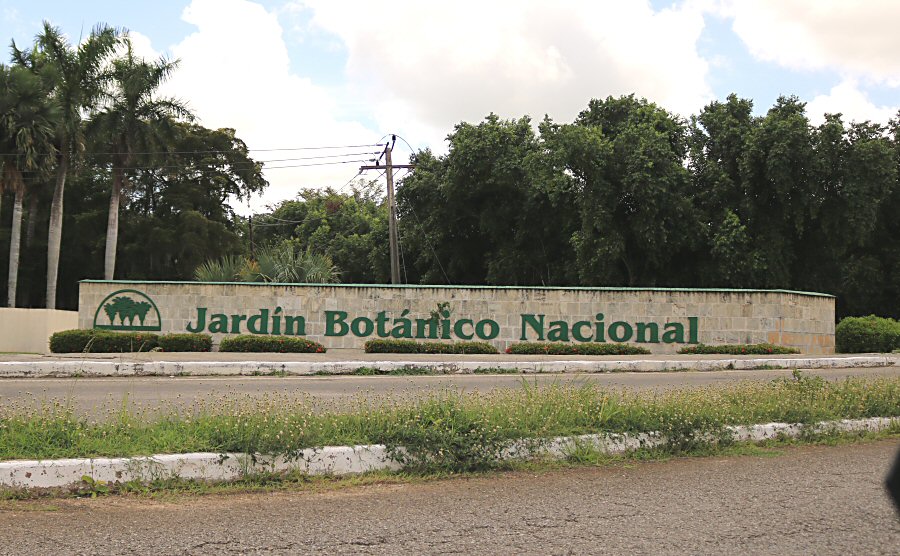
A feverish work began. Fidel Castro, a frequent visitor to the region, also provided the first equipment, including tractors and bulldozers. Temporary nurseries were built. Exploration trips were organized to the eastern provinces to collect plants and seeds. In 1969, land was cleared to allow for the first large-scale planting of tree saplings, comprising 22.000 species of Cuban forest.
Between 1969 and 1972, the army engineers completed the
region's network of roads.
Permanent nursery buildings and the Plant Physiology
Laboratory were constructed. Temporary laboratory buildings,
a herbarium, and a library were prepared and put into
operation.
To facilitate the work, Fidel Castro allocated new equipment (dump trucks and backhoes) to the area. In addition, students and workers from the University of Havana and the Instituto Tecnológico Revolución collected more than 40,000 m³ of limestone rock which were used for the construction of the Coastal Maniguas zone which would attempt to recreate these ecosystems. Trucks were provided to transplant Cuban palms and other shrubs from across the country, which would primarily nourish the Coastal Bushes, Palmetum, and Serpentine Vegetation zones.
In the early 1980s, the construction activity began to
develop, accelerating in 1983 as the opening of the center
was imminent.
The temporary exhibition pavilions and two cafeterias were
built.
Thus, after an extraordinary effort, the National Botanical
Garden opened its doors to the public on March 24, 1984.
Although the Botanical Garden was opened to the public, it
took years for the architects, botanists, and engineers to
design the grounds. After all 1,400 plant species and
varieties were planted on an area of 4,170 m², a new opening
was held on March 8, 1987.
In July 1987, the Japanese Ambassador to Cuba proposed to
the Ministry of Higher Education, through the Ministry of
Foreign Affairs, the idea of building a Japanese Garden as a
gift from the government of Japan to commemorate the 30th
anniversary of the Cuban Revolution. The Japanese Embassy
with the collaboration of Commemorative Association for the
World Exposition of Japan would cover the garden's
construction costs and even provide financing for Yoshikuni
Araki, a renowned Japanese landscape architect from Osaka.
Following the necessary consultations and approval by
government, work began in the second half of January 1989.
Nine months after the start of work, on October 26, 1989,
Fidel Castro inaugurated the Japanese Garden.
The National Botanical Garden of Cuba (NBGC), administered by the University of Havana, is situated on a vast land area of approximately 600 hectares and is home to more than 4,000 plant species.
Its founding purpose was to promote knowledge about aspects
related to plants in the general population, by emphasizing
a notable focus on the native flora and the tropical plant
diversity.
NBGC was inaugurated by Fidel Castro on January 4, 1989 in conjunction with Expocuba which is the largest exhibition center of Cuba.
HISTORY
Despite being a country of rich flora and diverse
vegetation, Cuba has not produced a Cuban botanist of note
for many years. The first botanical garden was founded in
1817 on the land where Parque de la Fraternidad and the
southern wing of the Capitol occupies today. This privately
owned land, named Jardín Botánico Carlos III de España, was
exchanged for another plot of land in a highly controversial
manner. El Capitolio was built in its place, and the Havana
Railway Station was built on the exchanged land, which was
less valuable. In 1864 the Botanical Garden, in turn, was
moved to Quinta de los Molinos, next to the rest house of
the general captains in the Molinos del Rey. The area was
called Jardín de Tacón before.
The Botanical Garden was managed by the University of Havana
from 1850 to 1871. After eight years in that the government
undertook the basic works like the drainage system, cisterns
etc., the Botanical Graden returned to the management of the
university that established the Botany School in Quinta de
los Molinos.
In October 1966, the young German botanist Dr. Johannes
Bisse arrived in Cuba as the Visiting Professor at the
University of Havana. Admiring the richness of Cuban flora,
Bisse met Fidel Castro in 1967 and convinced him to
establish a national botanical garden. Indeed, in his speech
on the occasion of the inauguration of the town of Valle
Grande on January 6, 1968, Fidel Castro for the first time
mentioned the establishment of a National Botanical Garden.
Dr. José M. Miyar Barruecos, the rector of the University of
Havana at that date, began working with Prof. Dr. Johannes
Bisse on the National Botanical Garden Project. The site
where the botanical garden is located today, approximately
25 km south of the capital, was chosen as the location.
Wednesday - Sunday
09:00 - 16:00
NBGC is located approximately 25 km south of Havana, Cuba . It can be reached via the Carretera del Rocío, km 3,5, Calabazar, Boyeros, Havana.
